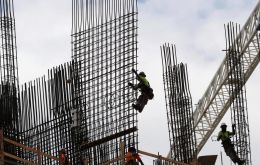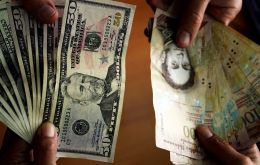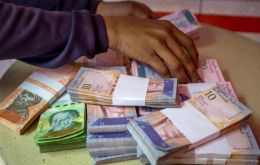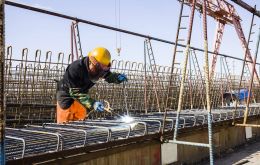MercoPress. South Atlantic News Agency
Tag: economic crisis
-
Wednesday, March 27th 2019 - 20:54 UTC
Dollar rises in Uruguay while tension increases in Argentine markets

In Uruguay, the dollar traded at noon on the state bank Banco Republica (Brou) board at $ 33.20 for the purchase and $ 34.60 for the sale, 45 cents above the close price on Tuesday. On the board of private exchanges, the currency to the public came to sell at $ 34.80 and $ 34.90.
-
Wednesday, March 13th 2019 - 20:09 UTC
The best and the worst city to live in Latin America

Caracas, in the last place, and Montevideo ranks as the two opposite poles of the list of cities ordered by quality of life in Latin America in 2019, according to Mercer. The capital of Austria, Vienna, ranked for the tenth consecutive year as the best in the world.
-
Thursday, February 7th 2019 - 09:57 UTC
Argentine construction industry activity in the doldrums

The construction industry in Argentina ended 2018 with a paltry 0.8% growth, and although taking off at the beginning of last year with a vigorous impulse but beginning May, when the financial situation forced the Peso to lose half of its purchasing power, activity started to freeze ending December with a 20.5% collapse.
-
Tuesday, January 29th 2019 - 09:03 UTC
Venezuela approves a new, privately run, foreign exchange system; dollar sells at 3.200 Bolivars, 34% dearer

Venezuelan authorities on Monday approved a new, privately run foreign exchange system that will operate in parallel to the official currency control system, as an emboldened opposition challenges President de facto Nicolás Maduro.
-
Saturday, January 19th 2019 - 09:13 UTC
Argentina complies with IMF 2018 primary fiscal deficit target: 2.4% of GDP

Argentina outperformed its primary fiscal deficit target for 2018, Economy Minister Nicolas Dujovne said on Friday, assuring that the country’s standby finance deal with the International Monetary Fund remains on track.
-
Friday, January 18th 2019 - 10:04 UTC
Wholesale prices in Argentina reach 73.5% in 2018; Peso rallies 10% in the midst of recession

Wholesale prices in Argentina shot 73.5% higher in 2018, government data showed on Thursday, the fastest rate since 2002 when they climbed 118% during an economic crisis that tossed millions of middle-class Argentines into poverty.
-
Tuesday, December 18th 2018 - 09:35 UTC
Creditors demanding payment of US$ 1.5 billion Venezuelan bond in default

A group of creditors has demanded payment on a US$ 1.5 billion Venezuelan bond that is in default, their lawyer said on Monday, kicking off a long-awaited showdown between creditors and the crisis-wracked OPEC nation. President Nicolas Maduro’s government and state-owned companies owe nearly US$ 8 billion in unpaid interest and principal following this year’s default on bonds amid a hyperinflationary collapse of the country’s once-wealthy socialist economy.
-
Thursday, December 6th 2018 - 08:45 UTC
Argentine manufacturing and construction declines during October

Manufacturing in Argentina fell 6.8% in October year on year, while construction declined 3.7%, and in the first ten months of this year 2.5% and 4.9% respectively according to the Indec statistics bureau report. Firms were hit hard by a contraction in economic activity and the devaluation of the Peso against the US dollar.
-
Friday, November 23rd 2018 - 09:45 UTC
Argentina: waiting for a strong agriculture recovery to help end recession

The industrial production in Argentina dropped 4.8% in October compared to the same period a year ago, accumulating a seven-month consecutive slide, according to the Center of Economic Studies from Orlando Ferreres. Between January and October manufacturing activity registers a 3.5% contraction relative to the same period in 2017.
-
Wednesday, October 24th 2018 - 08:40 UTC
Argentine Peso slips on Tuesday; central bank sells debt notes at a rate of 71.39%

Argentina’s peso slipped on Tuesday, a day after the central bank’s new governor reassured the public that its approach to taming the country’s rocky economy would be sustainable over the medium term. The peso closed 0.46% weaker at 36.65 per U.S. dollar. The currency has fallen 0.30% against the dollar this week, although it has climbed 12.63% since the beginning of the month.
